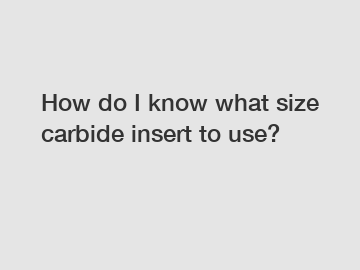How do I know what size carbide insert to use?
Carbide inserts are a critical part of many machining operations. Choosing the right size insert can make a significant difference in the quality of your work and the efficiency of your process. But with so many sizes and styles available, how do you know what size carbide insert to use?
First and foremost, it's essential to understand what carbide inserts are and how they work. Carbide inserts are replaceable cutting tips used in machining processes such as turning, milling, and drilling. They are made of a hard and durable material called carbide, which allows them to withstand high temperatures and speeds, making them ideal for cutting metal and other materials.
The size of a carbide insert refers to its dimensions, including its length, width, and thickness. These dimensions vary depending on the type of cutting operation and the material being cut. For example, a larger insert may be needed for heavy-duty cutting tasks, while a smaller insert may be more suitable for precision work.

When choosing the right size carbide insert, there are several factors to consider. The first factor to consider is the type of cutting operation you will be performing. Different types of inserts are designed for specific cutting tasks, so it's crucial to match the insert size to the job at hand.
For example, if you are turning a large diameter workpiece, you will likely need a larger insert to provide the necessary cutting edge. On the other hand, if you are drilling small holes, a smaller insert may be more appropriate. It's essential to consider the size of the material being cut and the depth of the cut when selecting the right insert size.
Another factor to consider is the material you will be cutting. Different materials require different types of inserts, so it's essential to choose an insert that is designed for the specific material you will be machining. For example, cutting aluminum requires a different type of insert than cutting steel, so be sure to select the right insert for the job.
In addition to the type of cutting operation and material being cut, it's also essential to consider the speed and feed rate of your machining process. The size of the insert can affect the speed and feed rate at which you can safely cut material. Larger inserts can typically handle higher speeds and feed rates, while smaller inserts may be more suitable for slower operations.
It's also crucial to consider the rigidity of your tool holder and the machine spindle when selecting the right size carbide insert. Using an insert that is too large for your tool holder or spindle can lead to poor cutting performance and premature wear on the insert. Be sure to consult the manufacturer's recommendations for the maximum insert size that can be used with your equipment.
When in doubt, it's always best to consult with a machining expert or tooling supplier for guidance on selecting the right size carbide insert for your specific application. These professionals have the experience and expertise to help you choose the right insert size and type for optimal cutting performance.
In conclusion, choosing the right size carbide insert is essential for achieving high-quality machining results. By considering factors such as the type of cutting operation, material being cut, speed and feed rate, and tool holder rigidity, you can select the best insert size for your specific application. When in doubt, don't hesitate to seek advice from a machining expert or tooling supplier to ensure you are using the right size insert for your needs.
Want more information on Carbide button for Drilling Bits, carbide button bits, Carbide Blanks Round Prices? Feel free to contact us.
157
0
0


Comments
All Comments (0)